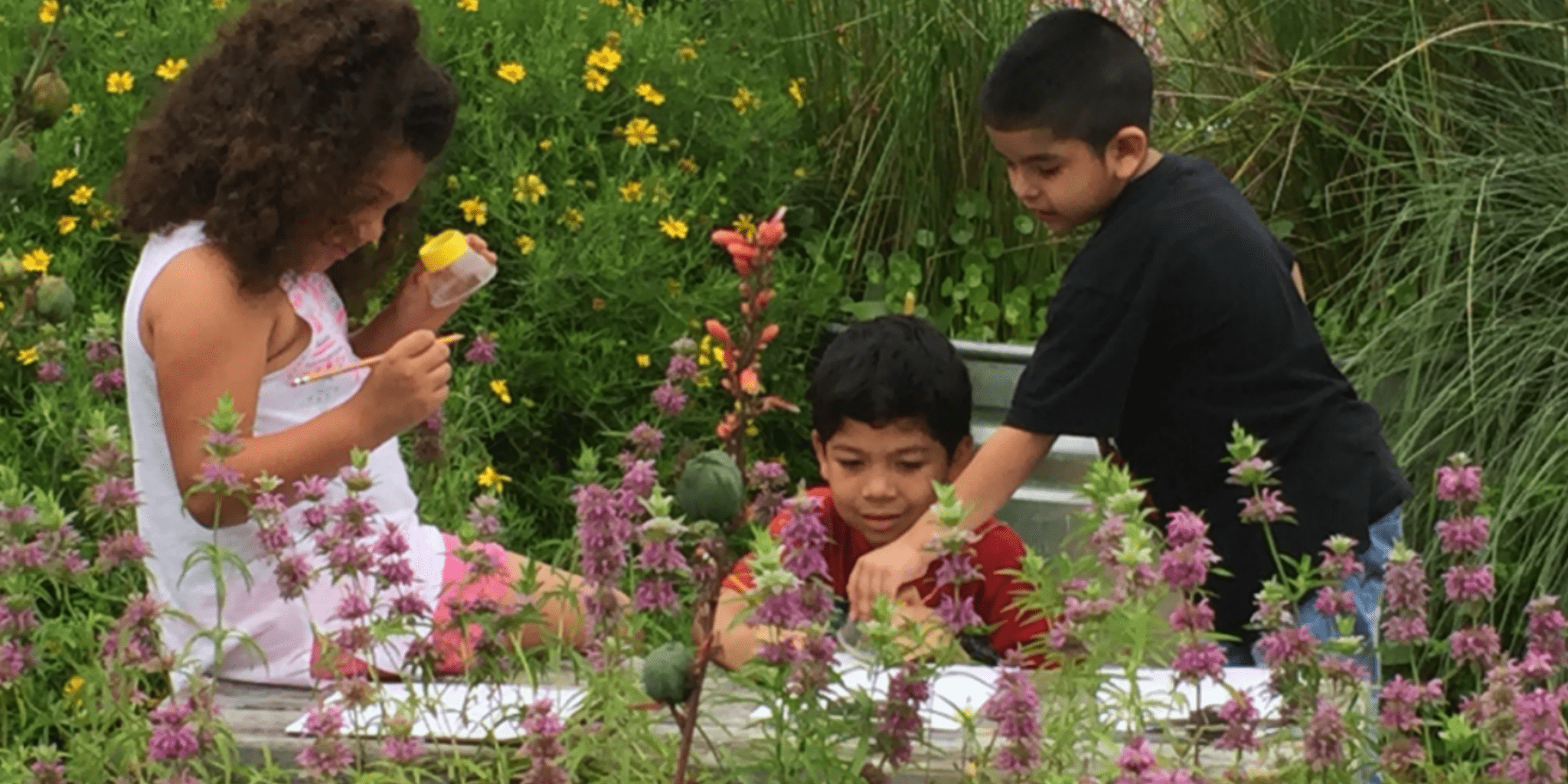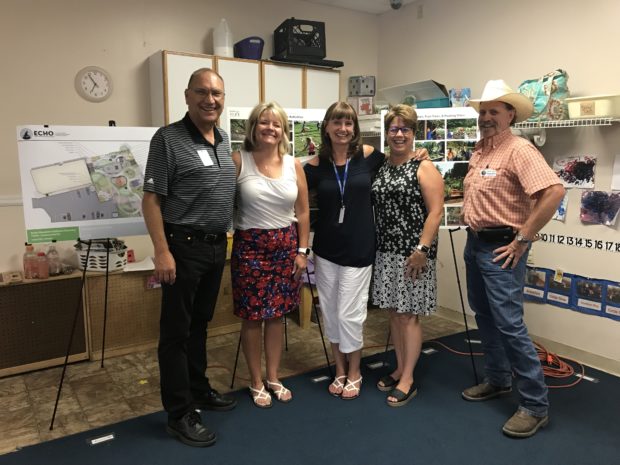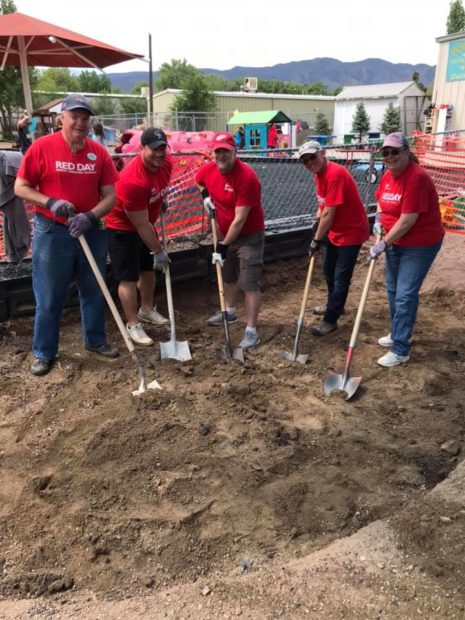We have much more to do and your continued support is needed now more than ever.
ECHO Q&A: Rocky Mountain Children’s Discovery Center

Early Childhood Health Outdoors (ECHO) is a National Wildlife Federation program that emphasizes the need for our youngest children to have daily, quality access to nature. Today, the amount of time kids spend outside is alarmingly low—only minutes per day—while screen time is at an all-time high. The National Wildlife Federation has set a new goal to stem the tide and move kids back outdoors.
Through a competitive application process, child care facilities are able to apply for ECHO grants and receive hands-on, tailored design assistance and implementation. Throughout the design process, these sites transform their play areas into a natural playground meant for outdoor learning, exploration in nature and developmental growth.
ECHO invests two-fold into the young children that benefit from this program. In naturalized environments, kids are able to explore the world around them and experience the earth, trees, insects and countless other elements that yield multi-faceted growth and lifelong memories. It’s this critical exposure to nature that creates a passion and love for the environment and animals that share our world, guiding their values into the future. They are our next generation of conservationists.
One of our 2018 demo sites, the Rocky Mountain Children’s Discovery Center in Cañon City, Colorado has been an enthusiastic and exemplary facility that has taken full advantage of everything ECHO has to offer. We sat down with Directors Cheryl Gould and Sharyl Boehm to talk about their experience and why they chose to naturalize their outdoor environment.
Q: How did you hear about the ECHO program and what made you want to apply?
A: Rocky Mountain Children’s Discovery Center heard about the ECHO program after receiving the Colorado Healthy Beginnings Grant. We were so excited about the CHBG grant and saw how the ECHO grant could be used in tandem to enhance our playground and bring those natural elements. We have always seen our playground as a pile of pea gravel, once we saw the possibilities and opportunity with ECHO, we knew we wanted to get involved with the program.
Q: What was the initial design process like, were there any surprises or interesting/unexpected things you learned?

A: The initial design process was amazing! We had so much fun and didn’t want to stop, everything was so organized and we saw our designs come to life in the form of little pieces of paper. Even though our beginning designs were all in marker with paper and tape, this process meant something to us and made us excited for the journey and transformation! Later, the ECHO team provided us with professionally designed blueprints that would guide us through the new changes and additions. Although it can be overwhelming, we couldn’t wait to get going and up until then we didn’t know exactly what was going to happen.

Q: What elements or features did you want incorporated into your design and why? Were you looking for anything in particular going into this?
A: We started with an open mind. Our infant and toddler playground was being reconstructed through the Colorado Healthy Beginnings Grant, however when we were designing the new ECHO space we had to redesign the toddler area as well if we wanted it to all blend! We knew we wanted a grassy mound with a slide, a bigger space for children to ride their bikes, and a mud kitchen to encourage kids to get their hands dirty and use their imagination!
Q: Once you received and presented your design, what has been the reaction of parents and families from your facility? How did you gain their support?
A: Every parent we have talked to about volunteering to help build our new space has jumped at the opportunity! We are so excited and grateful for the participation and help from families. We have had a construction crew build stages and our mud kitchen, with heavy equipment donated for us to use! We even had parents donate tires for us to use as features and planters! How did we gain their support? We just asked! And smiled a lot!
Q: How has the community supported this effort, what role did they play in finding/supplying materials?

A: The community has really rallied behind us. Home Depot donated paint supplies and sand paper for the tires, Habitat Restore gave us discounts for stains for the wood logs, a tree cutting company gave us logs, families donated time and built things like a t-pee for a vine pole, garden centers donated planting soil, a hardware store donated trek decking for our stages. We have been so fortunate and have built such strong partnerships in our community! Our local Head Start staff also referred the Soil Conservation specialist to our program to help us with our garden. She has designed our planter boxes and flower beds along with support throughout the summer! We even have a construction company who offered to build our pergolas. To top it off, Keller Williams Real Estate commits to only one community project a year and they chose us this year to bring approximately 15 real estate agents to our center in mid May to organize and plant the garden space.
Q: What outcomes or changes are you looking forward to throughout this process?
A: We are so excited to see this transformation come alive in the next few months, but especially looking forward to the parent’s reaction to the newly designed space and natural pieces throughout. We’ve been able to imagine the possibilities even though the space is still dirt, so it’ll allow our vision to come full circle and the families to see what we’ve been dreaming of. We’re excited for the children’s natural play space to change the way they interact with each other and nature, and of course we can’t wait to remove all this unending pea gravel! We are also excited for the dedication of “Breanna’s Magical Garden,” and to plant trees and grasses! We can go on and on!
Q: Lastly, what would you say to someone who is considering applying for an ECHO seed grant or looking to transform their space into a more naturalized area?
A: The Echo Seed Grant is a game-changer and can transform playground space into a natural oasis filled with learning opportunity. Really think about the long lasting impact you want to make and changes you want to see. Think about community partners that can contribute by donations and work. We have been really creative and have asked parents and community members to donate their time and skills. For instance, stumps take a lot of time and work before they can be used. We have a parent in a hard situation with four kids that can’t afford childcare, but has all the skills and wood working tools that he is trading for. It’s a win-win! For this particular grant, we involved key lead teachers in the process from writing the grant to implementing the transformation. We invested in their knowledge by paying for the cost to attend the ECHO Summit at the Denver Botanic Gardens, which was the spur of the whole project. We always apply for any grant that improves the quality of play pace for children and provides better opportunities to interact with nature — so go for it and be flexible with your plans as they may change half way through. You will have wonderful support through the National Wildlife Federation and the ECHO team!
Combining Nature Play with Conservation
Through unstructured play in nature, our youngest children are able to get their hands dirty, explore a continuously changing, dynamic environment, and learn why conservation is the key to preserving everything that makes an ECHO space unique. Our mission is to benefit the emotional, physical, cognitive, and social development of our kids while creating the next generation of conservationists. Our children will one day guide the policy and future of our world and by exposing kids to nature early on, we’re setting the stage for a future of people who care about their environment and the wildlife that depend on it.
To learn more about ECHO, visit https://www.nwf.org/ECHO and follow us on Facebook and Twitter.
Like what you read? Please consider making a donation to support programming like this:




















